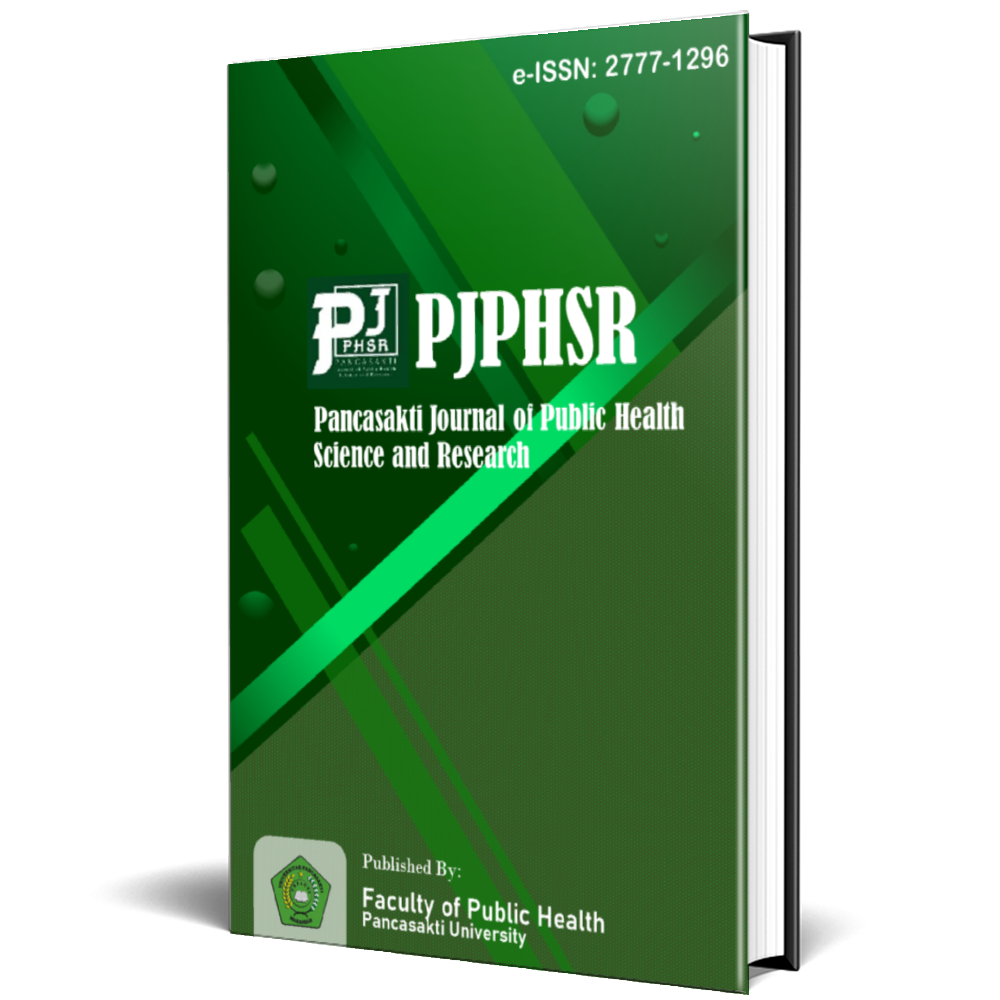Determinants of Unmet Need for Hormonal Contraception in Couples of Fertilizing Age (PUS) at the Faculty of Public Health, University of Muslim Indonesia
Abstract
The high rate of unmet need is a demographic phenomenon that constitutes an important aspect to consider in the future development of family planning programs. Unmet need refers to married women who are sexually active but do not use contraceptive methods, despite expressing a desire either to delay childbearing or to stop having children altogether. One of the consequences of unmet need is the increased incidence of unintended pregnancies (UPs). Unintended pregnancies include both mistimed and unwanted pregnancies. This study aimed to analyze the determinants of unmet need for hormonal contraception among female students at the Faculty of Public Health, Muslim University of Indonesia. This research employed an analytical survey method with a cross-sectional study design. The sampling technique used was total sampling, and data were collected using a structured questionnaire. Statistical analysis was performed using the Chi-square test. The findings revealed no significant association between parity and unmet need for hormonal contraception (P-value = 0.541 > α = 0.05), no significant association between contraceptive side effects and unmet need (P-value = 0.061 > α = 0.05), and no significant association between husband support and unmet need (P-value = 1.000 > α = 0.05). There is no significant relationship between parity, side effects, or husband support and the unmet need for hormonal contraception.
References
Bappenas (2017) Rencana Pembangunan Jangka Menengah Nasional (RPJMN) 2015-2019. Jakarta.
BKKBN (2009) Pedoman Pelayanan KB dalam Jaminan Kesehatan Masyarakat. Jakarta.
Husnah (2011) Faktor yang Berhubungan dengan Kejadian Unmet Need di Kecamatan Ujung Pandang Kota Makassar.
Kandel, N. (no date) ‘Unmet Need For Contraception and Its Associated Factors Among Married Women of Reproductive Age In Simichaer VCD of Gulmi District’, Health Prospect, 11(1).
Kementrian (2016) Profil Kesehatan Indonesia. Jakarta.
Khalil (2018) ‘Unmet Need and Demand for Family Planning Among Married Women of Abha, Aseer Region In Saudi Arabia’, Middle East Fertility Society Journal, 23(1), pp. 31–36.
Mardiyah (2019) ‘Perempuan Unmet Need di Kabupaten Lombok Timur (Studi Pengaruh Variabel Demografi, Sosial, Ekonomi, Sikap dan Akses Pelayanan terhadap Unmet Need Index Pedesaan dan Perkotaan.’
Mayla, Kholisotin and Agustin, D. Y. (2019) ‘Pengaruh Efek Samping Penggunaan Kontrasepsi Terhadap Kejadian Unmet Need Di Wilayah Kerja Puskesmas Klabang Kabupaten Bondowoso’, Jurnal Ilmu Keperawatan (Journal of Nursing Sciences), 8(1), pp. 53–65.
Nurhalimah, S. (2020) ‘Kejadian Unmet Need Alat Kontrasepsi’, Higeia Journal of Public Health Research and Development, 4, pp. 733–746.
Ökem, Z. G. and Pekkurnaz, D. (2023) ‘Determinants of unmet need for family planning: Evidence from the 2018 Turkey Demographic and Health Survey’, Journal of Biosocial Science, pp. 90–103. doi: 10.1017/S0021932023000123.
Rahmawati, S. (2011) ‘Faktor-faktor yang Terpengaruh Terhadap Kebutuhan KB yang Tidak Terpenuhi (unmet Need For Family Planning) di Kota Kediri’, Jurnal Kebidanan Panti Wilasa, 2(3).
Ratnaningsih (2019) ‘Analisis Dampak Unmet Need Keluarga Berencana terhadap Kehamilan Tidak Diinginkan di Rumah Sakit Panti Wilasa Citarum Semarang’, Jurnal Kebidanan, 7(2), pp. 80–94.
Sariyati, S, D. (2013) ‘Gambaran Keinginan unmet need terhadap Pelayanan KB di Kota Yogyakarta’, Journal ners & Midwifery.
Siregar, N. et al. (2021) ‘Faktor Yang Berhubungan Dengan Kejadian Unmet Need Pada Pasangan Usia Subur (PUS) Di Desa pasir Matogu Kecamatan Angkola Muaratais Kabupaten Tapanuli Selatah Tahun 2021’, Jurnal Kesehatan Ilmiah Indonesia, 6(2), pp. 67–79.
Uljanah, K. (2016) ‘Hubungan Faktor Risiko Kejadian Unmet Need KB Kecamatan Adiwerna, Kabupaten Tegal, Triwulan III’, 4.
Usman Lisdiyanti, D. (2013) ‘Faktor yang Berhubungan Dengan Kejadian Unmet Need KB Pasangan Usia Subur Terhadap Kehamilan Yang Tidak Diinginkan’.
WHO (2019) Proportion of Demand For Family Planning Satisfied (Met Need for Contraception), Health Situasion and Trend assesment Perspectives.
Yarsih (2014) Hubungan Sosiodemografi, Sikap dan Dukungan Suami Dengan Unmet Need Keluarga Berencana di Desa Amplas Kecamatan Percut Sei Tuan Kabupaten Deli Serdang.
Copyright (c) 2025 Nia Karuniawati, Fatma Jama, Andi Masnilawati

This work is licensed under a Creative Commons Attribution-NonCommercial-ShareAlike 4.0 International License.








